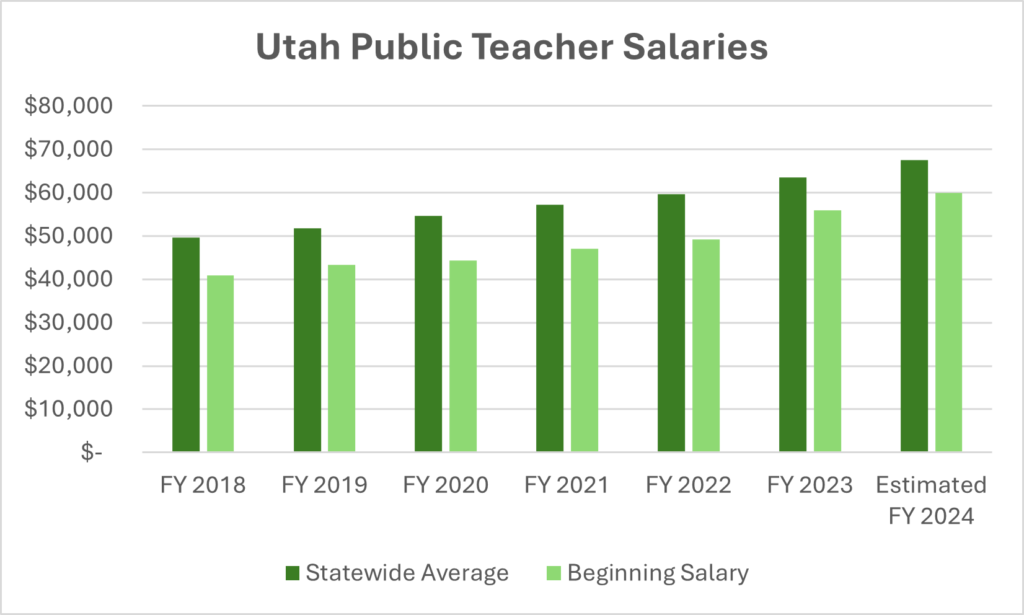Salaries have long been a focal point in discussions about education funding. Teachers are fundamental to our educational system, and debates about their compensation have focused on adequacy, fairness, and impact on recruitment and retention. In Utah, salaries for public educators are comprised of state, local, and federal funds. Ultimately, the total amount a teacher is paid is decided by individual school boards (Local Education Agencies, or LEAs). This post covers recent legislative actions affecting the state’s pay of Utah’s public school educators.
Salaries by the Numbers
During the 2023 General Session, the Legislature passed H.B. 215, “Funding for Teacher Salaries and Optional Education Opportunities,” which provided a $196.9 million ongoing for increases in teacher pay starting in FY 2024. In the same session, the Legislature passed S.B. 183, “Educator Salary Amendments” which included provisions for annual compensation adjustments. These adjustments aim to provide additional funding each year based on inflation and increases in the WPU value, ensuring that the value of direct state funding for teacher salaries is maintained over time.
According to the Utah Superintendent Association, starting salaries for new teachers have increased to nearly $60,000 for Fiscal Year (FY) 2024, marking a 35.1% increase over the past five fiscal years. The estimated statewide average teacher salary for FY 2024 was a little over $67,600, representing a 23.6% increase in pay since FY 2020. According to a December 2023 report by the Kem C. Gardner Policy Institute, Utah’s teacher starting salary is the second highest in the nation, while the average salary ranks 26th. The report also concludes that pay increases are the largest factor in teacher retention.
The table and graph below have detailed information on salaries by fiscal year for public schools (including district and charter schools).
| FY 2020 | FY 2021 | FY 2022 | FY 2023 | FY 2024 (Estimated)* | |
| Starting Salaries (New Teachers) | $44,374 | $47,072 | $49,263 | $55,984 | $59,954 |
| Statewide Average Salaries | $54,676 | $57,221 | $59,671 | $63,481 | $67,581 |

The Office of the State Auditor in Utah provides an interactive dashboard for viewing trends in teacher wages and benefits within the state. It allows users to filter data by school year, pay type, full-time equivalent (FTE) status, and more. The dashboard also provides summary information categorized by teachers’ degree levels and years of experience. This data can be viewed according to LEA and by individual schools.
Recent Legislation
While compensation for public educators is decided on a local level, these recent efforts by the state are designed to promote recruitment and retention of Utah’s teachers, with the goal of improving outcomes for Utah’s students.
H.B. 215 (2023) – Funding for Teacher Salaries and Optional Education Opportunities
One of the most significant changes in state funding for salaries, this legislation doubled the state teacher salary supplement from $4,200 to $8,400.The bill also provides scholarships for educational choices for families.
S.B. 183 (2023) – Educator Salary Amendments
This legislation provides salary adjustments matching the increase in the Weighted Pupil Unit (WPU) value from the previous fiscal year. This ensures that teacher salary adjustments reflect the same percentage increase as the WPU, so that compensation enhancements are designed to keep pace with inflation. The bill resulted in an expected increase for the state portion of $8,900 for FY 2025.
S.B. 2 (2024) – Educator Professional Time
This bill provides $74 million one-time for up to 32 hours of paid professional time for every educator.
S.B. 173 (2024) – Excellence in Education and Leadership
$150 million one-time to create and enhance teacher salary supplement opportunities.
H.B. 431 (2024) – Teacher Retention
While indirectly tied to compensation, the focus of this legislation is training and developing teacher-leaders. The grant funds a district may receive can be used to fund time for educators to perform teacher-leader work, extend contracts (resulting in more pay) for teacher leader work, or expand teacher leadership tracks.